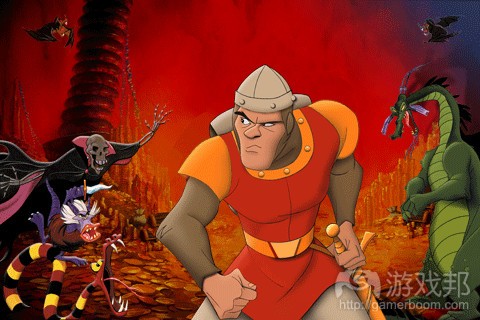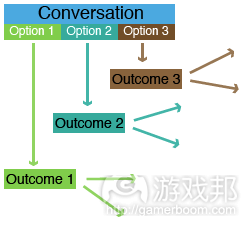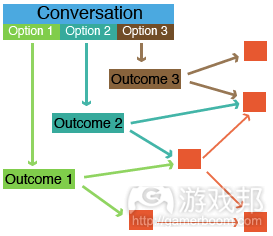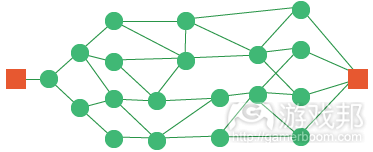探讨故事驱动游戏的结局设计方法
作者:Alex Moore
《质量效应》三部曲的完结在论坛和新闻站点引发了大量的讨论,最初众人表达的想法是希望游戏能够产生其他结局,期望Bioware能够做出回应。Kyle的文章谈到了一个期望,而我想用这篇文章来传达另一个略有不同的期望。这个期望并非直接针对《质量效应》,而是对内容驱动游戏制作方法的期望。
理解
从众人表达期望的言语上来看,我觉得许多玩家并没有理解电子游戏制作所需投入的精力,尽管他们在这三部曲中投入了数百个小时的时间。有人会认为,玩家不需要知道这些。我们观看电影,但是也不知道将图片和音效投放到屏幕过程中所涉的复杂过程。那么,为何玩家需要知道游戏制作过程中的痛苦和汗水呢?
部分电影确实激发粉丝对导演提出更多要求,但这些粉丝往往能够找到其他发泄的途径,比如用Youtube、漫画书甚至小说来表达不同的结局。但是,用来制作视频游戏其他结局的工具相当稀少,所以就导致粉丝向开发者施加压力。撇开资金问题不谈,内容驱动游戏不能拥有无数结局的原因在于:根本不可能制作和测试如此多的内容。
为向玩家解释这种限制,《质量效应》三部曲将游戏体验融入玩家操作的方法看似赋予玩家非凡的能力和创造力,希望通过这种方式自然地让玩家认为游戏是专门为他们设计的。不幸的是,开发者的目标并没有实现。
解析
我将在下文通过快速解析《龙穴历险记》来展示如何设计内容驱动游戏。这款游戏很简单:游戏播放美丽的动画,在预设点会发生某些事情,玩家需要按动按键来做出响应。你可以搜索查看整个游戏的通关视频。
在整个通关过程中,玩家死亡的次数并不多,因为玩家知道自己在做什么事情。但是,在流畅运行的动画之后,是个等待玩家输入的系统。如果玩家错失了输入的机会,游戏就会朝分支方向发展,玩家就会死亡。如果他们点击了窗口,就可以继续进展下去。
不同公司会用不同方式来呈现分支,比如节点、支线和门。但对本文而言,它们从本质上都是相同的。《龙穴历险记》是通过门来创造玩家选择的最简单例子。每个结果都是手工制作完成,游戏设计在所有细节方面都做了规划。
《龙穴历险记》的设计和流程架构可能需要数周的时间,而真正制作内容花了7个月和100万美元。这是款1983年的游戏,在当时的情况下这可是一大笔钱。而这样的大笔投入制作出的却是我们在10分钟左右就能完成的游戏。
测试
对于游戏制作的内容和编写的代码,它们都需要进行测试。当游戏框架和主要机制确定下来时,就要制定测试计划。测试计划制定完成后,就可以制作出测试列表和预期结果。根据这份列表,测试团队可以对游戏做常规检查,确保游戏的表现与预期相同。
上图的测试计划如下图所示:
从图中可以看出,单个门产生的序列可能会需要8项测试,甚至还可能需要更多。但是,像这样呈现8项测试便足以说明测试是游戏制作中最困难的部分。因此,比《龙穴历险记》更复杂的游戏会出现更多的结局也就不足为奇了。
玩家可能需要经过成百上千次的输入才到达某个点。如果出现漏洞,那么开发者就需要找到重新制作的方法,这样他们就能够理解出现偏差的地方并将其修补。
我需要强调的是,射击机制与门的内容有很大的不同,因为前者是拥有一整套预设规则的内容。当玩家做某些事情的时候(游戏邦注:比如按动开火键),决定所发生事情的是规则而不是内容。所以,测试计划无需将玩家在每个地点按动开火键的情况包括在内。
我在本文描述的门只在大故事点起作用,比如《战争机器》中玩家面临的“路径”类型选择。
扩展
现在,我们知道了单个门所需的细节层次,我们就可以知道如何放大扩展成多个门。在《质量效应》中,每个对话往往都有许多种可能的结果,尤其是与关键角色的对话。玩家所要求的互动与《龙穴历险记》中的动画窗口系统大为不同,但是其潜在系统却极为相似:
现在,我们面对的情况是,每个对话有3种可能的结果,每个结果又有两个子结果,使对话产生的独特路径达到6条。根据设计的需要,游戏中有上百个对话。我们根本无法创造出这么多各不相同的门。所以,我们创造了许多最终路径相同的结果:
你会发现,通过使用这个系统,玩家无需尝试每个门都能够达到故事结局。
阻塞门
通过制作玩家完成游戏必须通过但可以自由选择通过方式的更大、单一的门,你可以更好地控制可能产生的结果数量:
在这个例子中,橙色的方框便是阻塞门。
像《质量效应》这样的游戏中设置了多个阻塞门,但是玩家要到达游戏结局却无需经过每个阻塞门。事实上,设计师在游戏中有意制作了大量的路径。但是,每个路径的发展方向都是经过计划和设计的,并针对该路径的过程制作内容。
这种设计方法不仅适用于故事的创作,还可以用在关卡设计和技能树上。《生化奇兵》便是将这种方法用于所有系统的绝佳范例。许多关卡会向你提供必须完成才能前进的目标,但是你可以选择以任意顺序来完成这些目标。
同样,故事感觉像是围绕着玩家进展。是否深入挖掘故事完全取决于你。位于故事之上的层次是你的能力和升级,这些都可以由玩家来做出选择。
游戏一直使用这个系统,直到你碰到Ryan。此时,所有玩家都必须通过一个只有唯一结果的阻塞门。也就是说,他们就别无选择了。我对《生化奇兵》这种做法的抗议就是退出游戏,所以我现在仍不知道游戏最终是何结局。
《质量效应3》显然使玩家产生了类似的反应,尽管这种反应比我的无声抗议更加强烈。在整个三部曲过程中,玩家一直在做他们认为独一无二的决定,游戏根据他们的决定做出响应。
《生化奇兵》所取得的成就令人难以置信,从外在来看能够给人们带来颇多灵感。但是,从逻辑上说,游戏不可能针对每种可能的结果设计结局,希望本文能够让众人明白其中的缘由。(本文为游戏邦/gamerboom.com编译,拒绝任何不保留版权的转载,如需转载请联系:游戏邦)
Opinion: The perception of interactivity
Alex Moore
The conclusion of the Mass Effect trilogy has spawned a great deal of chatter on forums and news sites alike, based initially on the online petition requesting extra endings and the growing responses from Bioware and others alike. Kyle’s post here covers one perspective, and with this post I aim to cover something slightly different one. It is not directly about Mass Effect, but instead about how content-driven games are made.
Understanding
It seems to me, from the way the petition is worded, that despite investing hundreds of hours in the trilogy, many gamers don’t understand the logistics involved in creating a video game. It could be argued that they shouldn’t need to – we watch films without knowing all the intricacies involved in getting the image and sound to the screen, so why should gamers need to know about the blood, sweat and tears that go into making games?
While some films do spark huge reactions toward the director from fans, those fans often find other outlets for their reaction, with alternative endings turning up on Youtube or comic strips or even novels. There are rarely the tools made available for alternative endings to be made for video games, which in turn leads to fans putting pressure on developers. Funding issues aside, there’s a big reason why a game driven by content cannot have infinite endings: it’s simply not possible to create and test that much content.
To expand on that statement, the way the Mass Effect trilogy melds the experience to the player’s actions puts a phenomenal sense of power and creation into their hands, and this naturally gives the impression that the game is crafted specifically to them. Unfortunately, it’s not.
Exhibit A
To give an example of how a content-driven game is designed, I’m going to have a quick look at Dragon’s Lair. If you haven’t played it, the premise is very simple: a beautiful animation plays out and, at a pre-defined point, something happens which the player needs to react to with a button press. This is a video of the full game being played all the way through.
The playthrough doesn’t show many of the player deaths because the player knows what they’re doing. But behind the smooth flowing animation is a system that’s waiting for a player input. If the player misses the window of opportunity, the game branches and the player dies. If they hit the window, they progress.
Different companies refer to these as different things – nodes, branches, gates. They’re effectively all the same and, for this post, I’ll stick with the latter. This example is the simplest gate required to create player choice. Each and every sequence has been hand crafted, and the game planned out in intimate detail.
To design Dragon’s Lair and sketch out the flow, it probably took a few weeks, though actually creating the content took seven months and 1 million dollars (source). That was in 1983, so in today’s money that’s a lot more. And all this for a game that can be completed in just over 10 minutes, as shown in the above video.
Testing
As well as creating the content and code, it all needs to be tested. Test plans come later down the development line, when the framework of the game and the main mechanics are close to being locked. Once that happens, it’s possible to create a list of tests and expected results. From here the test team can do regular checks to ensure the game is behaving as intended.
A test plan for the the diagram above might look something like this:
One sequence with a single gate therefore might lead to eight tests. Possibly even more. For now, though, that’s enough to highlight why testing is one of the most difficult parts of making games. It stands to reason therefore that in a game more complicated than Dragon’s Lair there’s going to be far more possible outcomes.
At any one point the player could have done one of a hundred things, let alone the thousands of small inputs they’ve made to get to where they are. If a bug surfaces, the developer then needs to find a way to recreate it so that they can understand what’s going wrong and then, hopefully, fix it.
I should note at this point that something like a shooting mechanic is very different from gated content, because that’s a system that has a set of defined rules. When the player does certain things (such as presses the fire button), the rules determine what happens, not the content. So the test plan doesn’t have to account for pressing the fire button at every possible position the player can get themselves into.
The sort of gates I’m describing here really only come into play at big story points, such as the ‘choose route’ type option presented to the player in Gears of War for instance.
Scaling up
Now we know the level of detail required for a single gate, we should now look at how we cope with multiple gates. In Mass Effect, each conversation often has a few possible outcomes, especially when they’re with key characters. The interaction required by the player is very different from the reaction-heavy animation window system employed by Dragon’s Lair, but the underlying system is very similar:
Suddenly we’re facing a bit of a crisis – one conversation with three possible outcomes, each with just two more attached to them has led to six unique paths. And the game design wants over a hundred conversations… There’s no real way that we can create that many unique gates. So, instead, we create paths that feed back into themselves further down the line:
You’ll notice that by using this system it’s entirely possible that the player won’t have to go through every gate to get to the end – in fact it’s desirably to do this to try and encourage replays.
Choke Points
You can keep even more control over the number of possible outcomes by creating larger, single, gates that the player has to go through to complete the game, but where they’re free to choose whatever route they desire in between:
The orange boxes in this case are choke points.
With a game like Mass Effect, there are multiple choke points, but the entire game is constructed of so many that the player doesn’t have to go through every one to get to the end of the game. In fact, there’s very purposefully a great deal of routes through the game. But every single route has been planned, designed and has had content created for it.
This type of design method isn’t just limited to stories, but can be used for level design or ability trees too. A good example of a game that uses this method for all of these systems is BioShock. Several levels give you objectives that you must complete to ultimately move forward, but you can do those objectives in whatever order you desire.
Equally the story feels to develop around you, the player. It’s up to you whether or not you delve deeper into the myth and seek out the audio diaries, and of course there’s the choice of how to deal with the little sisters. Layered on top of that are you abilities and upgrades, all at your choice.
It works really well, all the way up until the point where you meet Ryan. At that point, all players must go through a single choke point with only one outcome. Thus their choice is removed. My protest with BioShock was simply to stop playing – I still have no idea how it actually ends.
Mass Effect 3 has obviously created a similar reaction, though a much stronger one than my silent protest. Throughout the trilogy, players have been making what they believed were unique decisions, and the games responded accordingly.
The achievement by Bioware is staggering, and from an external perspective very inspirational. Logistically, though, there could never be enough endings to satisfy every possible outcome, and hopefully this post has gone some way to showing why not.
Disclaimer: I don’t work for EA or Bioware, and wasn’t involved in the creation of Mass Effect at any point. (Source: Gamasutra)














































 闽公网安备35020302001549号
闽公网安备35020302001549号